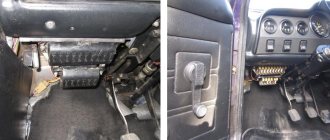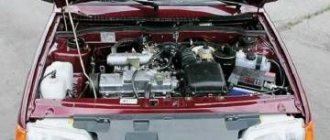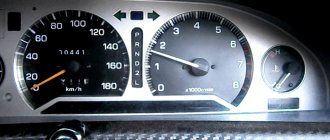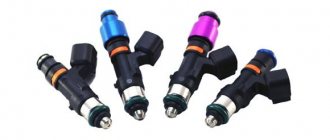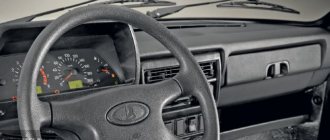As a rule, during operation, any power unit becomes less productive due to natural wear and tear. At the same time, the loss of power even on engines with a significant mileage is usually, on average, about 10% of the declared rating. Naturally, the driver practically does not notice such a decrease in performance.
However, if the engine's thrust is lost, the engine has lost its throttle response when the gas pedal is pressed, then operating such a power unit becomes difficult and even dangerous, and the problem itself requires a solution. At the same time, the owner may notice that the engine is difficult to start, both cold and hot. Smoky engine exhaust may also appear in different operating modes of the power unit (idling, smoking under load, etc.)
Next, we will look at the most common reasons why the engine stops pulling, does not respond in a timely manner to pressing the gas pedal, smokes, engine response disappears, etc.
Why doesn't the scooter pull?
Some motorcyclists are faced with a problem when the engine of the equipment works properly, but the scooter does not pull. The device simply does not move or moves slowly. Oddly enough, this is a fairly simple problem that even a novice rider can fix. Therefore, let's figure out why the scooter does not pull, and how to “reanimate” the equipment.
Do-it-yourself troubleshooting
It is possible to eliminate power failures on your own only when the reasons that caused the failures can be easily eliminated even by a novice car enthusiast.
In all other situations, you cannot do without the help of a qualified mechanic. The car will have to be taken to a car service center, since a novice car enthusiast will do more harm than good with his actions.
The worst thing about power dips is that they can be caused by a huge number of reasons. And identifying the real cause of failures can take a lot of time, much longer than the repair itself. Therefore, the most reasonable solution is to entrust the search for reasons to professionals. They not only have the necessary experience, but also a lot of special equipment. The only exceptions can be the cases mentioned above, when the cause of the problem lies on the surface.
Source
If the carburetor engine does not pull
First of all, carburetor engines do not gain speed due to the power system. Lack or excess of fuel are the main reasons for this. Mixing of air and fuel occurs directly in the carburetor, and the latter needs periodic cleaning and proper adjustment. Obviously, the lack of one of the components of the fuel mixture leads to a decrease in traction.
The correct fuel assembly ratio, for example, on a VAZ 2106 or 2107 is 15/1. If the amount of gasoline exceeds the norm, it does not burn completely, which reduces the engine response. In addition, fuel consumption increases significantly, which leads to other problems with the power unit. A small percentage of gasoline completely causes the engine to starve. And if the mixture is insufficiently ignited, the piston moves slowly.
Proper adjustment of the carburetor is a complex process that only specialists can do. First of all, the correct jets are selected - the air jet should be slightly larger in volume than the fuel jet. Then the float chamber is adjusted. The carburetor adjustment can be considered successful if the engine idle speed remains stable.
All answers
Barnaul
Unscrew the spark plugs. If they are white, it means the fuel is clogged. If they are black, it means there is air. Check the corrugations for ruptures and air leaks. I think it’s fuel. I need to change the mesh on the fuel pump and the fine filter. If it doesn’t help, then change the injectors. Cleaning is cheaper, but unreliable.
GRom 22rus;1169129822:
Unscrew the spark plugs. If they are white, it means the fuel is clogged. If they are black, it means there is air. Check the corrugations for ruptures and air leaks. I think it’s fuel. I need to change the mesh on the fuel pump and the fine filter. If it doesn’t help, then change the injectors. Cleaning is cheaper, but unreliable.
I changed the strainer on the fuel pump not long ago. The corrugations don't seem to suck. But the box itself where the air purification filter is located, it does not suck air at all. But strangely enough the car drives fine
Yes, and force me about 5 thousand ago, not very long ago in general
Barnaul
DhdndnAnton;1169130005:
I changed the strainer on the fuel pump not long ago. The corrugations don't seem to suck. But the box itself where the air purification filter is located, it does not suck air at all. But strangely enough the car drives fine
it sucks as much as it needs. If the fuel tank is clogged and there is not enough gasoline coming in, then it needs little air. It takes that much. You can, of course, measure the pressure in the fuel rail, but changing the filters is simply easier and cheaper. Well, if that doesn’t help, then measure the pressure and either clean the fuel rail, or remove the rail and look at the spray of the injectors, checking them. There is little chance that there is a problem with the air. There is, of course, a possibility that the problem is software or in the mass air flow sensor, but this already needs to be purchased for a good scanner or a used one. This will come later if simple options do not help.
GRom 22rus;1169130131:
it sucks as much as it needs. If the fuel tank is clogged and there is not enough gasoline coming in, then it needs little air. It takes that much. You can, of course, measure the pressure in the fuel rail, but changing the filters is simply easier and cheaper. Well, if that doesn’t help, then measure the pressure and either clean the fuel rail, or remove the rail and look at the spray of the injectors, checking them. There is little chance that there is a problem with the air. There is, of course, a possibility that the problem is software or in the mass air flow sensor, but this already needs to be purchased for a good scanner or a used one. This will come later if simple options do not help.
It would be worth the errors, there are no checks, no errors appear. And the most interesting thing is that the car is moving. So I can’t understand. If only she hadn't been driving until now and she's working fine
Barnaul
Well, then I don’t know. Maybe there was some kind of failure, maybe there was debris in the fuel tank. There’s no point in guessing. The symptoms will repeat, then do what is written above. First of all, the spark plugs and the color of the soot.
Replies: 2
Also look at the ignition module. The next time you lose traction while driving, just turn off the ignition and put it in gear, it will start and drive normally. It is possible that the module has worn out. There may also be high-voltage wires. For me, if you change a module, then the armor wires also need to be replaced.
Replies: 2
Look at the ignition module. Most likely it has malfunctioned. For example, you are driving in 3rd gear and the traction is gone. Turn off the ignition and turn it on (without turning off the gear) it will start and drive normally as usual. There is another possibility that the high-voltage wires have become faulty. But it’s better to check everything and draw some conclusions
14524523
Derbent
Replies: 1
Lost traction and stalled? it starts up, what should I do?
Replies: 1
Hello Victor! I have this, you go into 4th gear and the traction is gone, and I turn off the ignition and turn it back on and go back to my seat, what is the reason???
Replies: 1
Arman Ibrashev
Hello Victor! I have this, you go into 4th gear and the traction is gone, and I turn off the ignition and turn it back on and go back to my seat, what is the reason???
I had this happen too, the reason was in the first valve (it burned out), I had to change it, I’ve been driving it for 4-5 months now, again it doesn’t work in 5th gear, the traction completely disappears, I can’t figure it out, I turn it off and on while driving, still the same, and when the valve burned out, at least after turning it off and on it returned to normal, but now there is no effect, it still doesn’t work, there’s no point in turning it off and on all the same.
Replies: 1
Try replacing the fuel pressure regulator, and for complete happiness, clean the throttle valve with carb.
Replies: 1
Friends, I have such a problem, the VAZ 2114 loses traction at speeds 4 and 5 and the steering wheel vibrates! The head is not in use, the carbon has been cleaned, everything possible. It idles smoothly, it starts, I can’t figure out what the problem is. Maybe someone has encountered such a problem.
From Vladivostok and other cities of the Far East and back 8800-500-0936
Information on the VAZ 2114
Reasons for loss of power in a carburetor engine
Here it is worth immediately checking the fuel level and the operation of the fuel pump: “underfilling” of fuel immediately reveals itself under load as a loss in dynamics, shooting into the carburetor. Overfilling due to a faulty carburetor shut-off needle will also lead to a loss of engine power, here black smoke and firing from the muffler will become a characteristic sign.
The car's dynamics are perceived better when accelerating, so a defect in the accelerator pump may also be a possible reason for the car's “dullness.” The fact is that all carburetor systems are designed to operate in static modes; as the speed increases, the mixture becomes leaner. The accelerator pump is used to combat this over-depletion: when you press the gas pedal, the diaphragm pushes a dose of gasoline through the shut-off valve into the nozzles that exit into the diffusers. If the diaphragm of the accelerator pump ruptures or the nozzles become clogged, the acceleration of the car will immediately deteriorate so much that it is difficult not to notice. It’s not difficult to check the accelerator pump - after removing the air filter or “turtle” from the carburetor, you need to sharply press the throttle valve drive: your fingers will feel resistance (the diaphragm will create pressure in the accelerator pump), and streams of gasoline should hit the inlet from the nozzles.
Fuel filter/air filter
Your car may lose its former agility due to natural problems in the fuel system. For example, due to dirty fuel filters, the fuel supply to the engine may be disrupted. As a result, there will be a shortage of fuel, which will ultimately lead to a change in the behavior of the car.
Also, don’t forget about the air filter, which car enthusiasts often overlook when carrying out routine maintenance. The air filter plays an important role in your car. So, due to contamination of the air filter (attention: this is not a cabin air filter, which cleans the air coming from the street into the car interior), the engine may begin to experience oxygen starvation: the fuel-air mixture will not be enriched with the required amount of oxygen. As a result, fuel ignition will be incorrect, with all the ensuing consequences (loss of power, detonation, uneven engine operation, etc.).
Violation of valve timing
The main parts of the gas distribution mechanism (GRM) are the intake and exhaust valves. They are “obliged” to open and close only at the right moment so that the fuel mixture enters the cylinders on time and exhaust gases are removed. This process is called phase distribution. If it is violated, you will see that the power of the engine has disappeared, which will begin to “triple” and sometimes have difficulty starting.
Causes of valve timing violations:
- wear, as well as incorrect installation, displacement of the chain or timing belt (most often this is a jump by one tooth (link));
- play or deformation of the pulley on the crankshaft;
- wear of hydraulic compensators, camshaft and (or) its bed;
- burnout or rupture of the head gasket;
- Malfunction of the camshaft position sensor (DPRV).
To restore normal operation of the timing belt, it is necessary to set the position of the timing and crankshaft shafts according to the marks. If the chain is worn, replace it. The same applies to the camshaft with a bed, hydraulic compensators, gasket and DPRV.
Checking the transmission
Sometimes the power unit can develop serious power, but it does not reach the wheels. If while driving you hear that the engine is working hard, but you don’t feel speed, then perhaps the automatic transmission system is slipping or there are blockages on the brakes.
To check, you need to drive onto a straight section, set the automatic transmission selector to position D, and then see how the car behaves. If the speed decreases, then the brake system should be diagnosed. If everything is fine with the brakes, you need to go to a good service station and check the automatic transmission.
You can also check the parking brake. To do this, you need to go to free space. Warm up the car and then pull the handbrake. Next, press the brake pedal and set the gearbox selector to position D. Next, press the accelerator. If the engine keeps the rpm around 2000, then everything is fine with it. If it is less or more, you should go to a service station to test the automatic transmission.
How to assess the problem?
Troubleshooting based on the diagnosis of “poor diesel engine traction” is a rather difficult procedure. The fact is that there can be a lot of reasons for breakdowns, as we have already written, and therefore it is extremely important to have a complete history of the origin of the “car disease”. If such information is not available, the verification algorithm will become too extensive, because many parts can simultaneously cause a drop in power. Perhaps some electronic mechanism is not turning on the machine's systems. Perhaps one error leads to another. At times, diagnosing this issue looks very confusing.
In order to conduct a full diagnostic of your car, you need to have special tools to check each system. It is quite expensive to buy all this for self-diagnosis; it is much more profitable to contact Turbo Diesel Service. We are faced with these types of problems every day and over 7 years of work we have learned how to solve them effectively.
On diesel
Some of the reasons for power loss listed above are also relevant for diesel engines. But there are also a number of specific points associated with diesel engines that should be mentioned. One of the most common causes of power loss in a diesel engine is the failure of the turbocharger. When this unit fails, it usually begins to emit a characteristic whistle, which is difficult to confuse with something else. But in order to accurately determine the breakdown, you will have to send the car to a car service center. There they will scan it and identify the problem. Why might the turbo turn off? Here are some options.
A characteristic external sign of a compressor failure is blue smoke coming out of the exhaust pipe. It occurs due to the combustion of oil, the excess of which enters the combustion chambers of the cylinders due to leaks in the compressor. If the tightness of the compressor discharge line is broken, air leaks occur and the mixture becomes too rich. When it burns, not blue smoke comes out of the chimney, but black smoke. Finally, white smoke indicates that the oil line through which oil is drained from the compressor is clogged.
The car accelerates poorly - Section 3. Malfunctions on the road
There are many reasons for the deterioration of dynamics, the main ones can be defined as follows.
1. Engine malfunction: decreased compression in one or more cylinders, leakage of additional air into the engine intake tract. Coking of the exhaust system or damage to the exhaust gas converter (if the vehicle is equipped with a catalytic converter).
2. Malfunction of the power supply system: clogged injectors and fuel filter, hoses of the fuel supply system. Insufficient fuel pump supply. Use of low quality fuel.
Loss of traction due to a malfunction of the ignition system
After checking the spark plugs and coils, you need to pay attention to the crankshaft and camshaft position sensors. Incorrect data from these sensors, which they transmit to the control unit, can cause interruptions in engine performance. If interruptions in the functioning of these sensors are detected, they are replaced.
The last thing to check in the ignition system is the electronic control unit (ECU), since it is responsible for the fuel supply and the correct spark timing. A malfunction in its operation often leads to a significant loss of power. In some cases, in order to restore the functionality of the ECU, it is necessary to flash its firmware. Often the firmware removes the problem of loss of power from the power plant. But there are also cases when the control unit needs to be replaced.
Main reasons
There are many reasons for this phenomenon and in most cases they are associated with a malfunction of the systems and mechanisms of the power plant.
Some of them are trivial and very easy to fix, others require quite serious repairs.
The main problem with the fact that the engine does not pull is not related to eliminating the malfunction, but to finding it.
In some cases, it is very difficult to determine what caused the reduction in traction effort and you have to go through almost the entire engine.
Therefore, we will try to indicate the main reasons why the car accelerates very “sluggishly”.
Since engines on different cars have their own design features, we will consider specific models.
Checking power indicators on stands
The rollers with the braking system are clearly visible
Sometimes engine problems are not as obvious as shown above. But that doesn't mean they don't exist. The engine power may also decrease after unsuccessful chip tuning, but this can only be determined with the help of instruments. In such a situation, special equipment is used to check cars: a roller stand and a computer on which specialized software is installed. Such equipment makes it possible to check the parameters of machines whose power reaches 740 hp. With. to the axis. The car is fixed on the stand with a special mount, and its engine accelerates to maximum speed. All bench rollers have a brake system that prevents acceleration. As soon as the engine reaches maximum speed, the roller braking system is activated. And the car “rolls freely” until it stops. All this time the computer takes measurements. It records power loss in the transmission and a number of other parameters. Based on these measurements, the characteristics of the motor are calculated using special formulas and a graph is created that shows how the engine torque and its power depend on the speed. As a rule, there are 4 curves on such graphs. Two show power, two more show engine torque, and 2 curves are necessarily red, and 2 are black. The black curves show the torque and power of the engine with factory settings. And the red ones show torque and power after chip tuning (if any was carried out). Any power drawdown on a real engine is shown by the drawdown on the graph.
Malfunctioning spark plugs
The planned replacement of these elements of the ignition system is carried out after 20-30 thousand kilometers. If the spark plugs are platinum, the resource increases to 100 thousand km. However, the situation when candles (most often one of them) fail ahead of schedule is not uncommon.
This can be seen and heard by a number of signs:
- the engine starts with difficulty, especially in winter;
- idling is unstable, the tachometer needle jumps, the engine may stop periodically;
- when the power unit is operating, increased vibration is observed, for example, the gearbox shift lever shakes;
- poor acceleration dynamics - the car does not develop full power, it stalls;
- when you press the accelerator, “dips” are noticeable;
- fuel consumption has increased.
When one spark plug does not work, experienced drivers say that the engine is “troubling,” that is, only 3 out of 4 cylinders are working.
To find a faulty part, you need to:
- put on dielectric rubber gloves;
- with the engine running, disconnect the high-voltage wire from each spark plug one by one;
- in this case, the nature of the engine’s operation should change, the speed should drop, but if this does not happen, it means that the cylinder is not working - the spark plug does not produce a spark.
It is worth finding out the reason for the poor performance of the part; it is quite possible that it is defective. If other spark plugs subsequently begin to fail, you will have to look for the cause elsewhere - the CPG or the fuel system.
Damage diagnostics
How to understand that an injector needs to be replaced, checked or repaired? Even without sensors, you can understand that repair of fuel system elements is required if there are 1 of 2 main signs in models 2107, 21074:
The cause of such failures is clogged injectors; even diagnostics are not needed. Cleaning helps restore the engine to its original performance. If the problem has not been resolved after cleaning, it is worth checking the tubes and injectors for damage or breakdowns. In such cases, it is better not to start repairs, but simply replace the damaged parts with new ones.
Sometimes it is impossible to determine on your own where the damage is, and only then will diagnostics at service centers come in handy. A blockage can cause quite serious damage to the VAZ 2107 injector, as well as rupture of channels. The pressure that arises inside the system can easily destroy the most fragile parts. Here you won’t be able to fix the situation with your own hands, even if you have a complete diagram of the car at hand. There is only one conclusion - you need to devote a lot of time and attention to cleaning injectors and do it regularly.
Source
Compression reduction
Often, the reasons for loss of engine power can be associated with simple wear and tear of the power unit. Do not forget that a car aged about 100 thousand kilometers begins to lose its power by 10-15%. If you think the losses are excessive, you need to check the compression. Its nominal value is indicated in the documentation for the machine. For testing, you will need an inexpensive device - a compression gauge, which is a pressure gauge mounted on a hollow tube or connected to a rubber hose equipped with a tip. It is screwed into the cylinder block instead of a spark plug. Next, disconnect the high-voltage wire from the ignition coil. Crank the crankshaft with the starter and note the highest reading on the compression gauge. The operation should be repeated for each cylinder.
Compression check
Pressure below that specified in the instructions by more than 15% indicates wear of the rings, pistons, cylinder block walls, and valves. To solve the problem, you can bore the BC to the repair size, replace the piston rings, grind (or replace) the valves.
